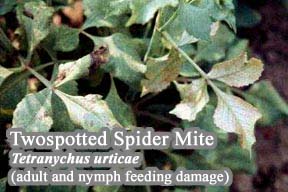Beebalm (Monarda)
Plant Health Problems
Diseases caused by Fungi:
Powdery mildew, Erysiphe.
White powdery spots or patches develop on leaves and stems. Symptoms often
first appear on the upper surfaces of the leaves. Heavily infected leaves turn
brown and shrivel.
Disease can be minimized by avoiding overcrowded spacing of plants and by
carefully picking off affected leaves as soon as symptoms are evident.
Symptomatic leaves can be placed into a plastic bag in order to avoid spreading
the spores of the fungus to other plants. Use of fungicides is usually not
necessary. However, for ornamental plants, applications can be made as soon as
symptoms are visible. Among the compounds registered for use in Connecticut are
thiophanate-methyl, potassium bicarbonate, and sulfur. Consult the
label for dosage rates and safety precautions.
Insect Problems
Aphids, Aphis monardae.
Beebalm is rarely infested by the aphid, Aphis monardae. When needed, it
may be managed by spraying with insecticidal soap, ultra-fine horticultural oil
or malathion, which are among the compounds registered for control of this pest
in Connecticut. Consult the label for dosage rates and safety precautions.
Stalk borer, Papaipema nebris.
The stalk borer occasionally tunnels in beebalm. This borer infests an
occasional stalk of many kinds of herbaceous plants and it frequently causes
rather severe injury to dahlia. As a rule its presence escapes notice until the
plant begins to wilt. Then it is too late for the plant to recover. The larva
tunnels up and down inside the stem, and the top portion usually wilts and
later dies. There is one annual generation. The moths emerge in September and
October and lay eggs on the stalks of their food plants, in which stage the
insect passes the winter. The eggs hatch in May or early June. The young larva
begins to feed on the leaves of the nearest food plant, and later tunnels in
the stem. The mature larva is nearly 1 1/2 inches in length, grayish brown with
one white dorsal stripe and two white lateral stripes on each side. On the
front half of the body the lateral stripes are interrupted, and the lower brown
stripe extends forward onto the side of the head.
Burning all the old stalks (if allowed) and destroying weeds at the edges of
the garden helps control this insect. When needed, methoxychlor, which is among
the compounds registered for use against this pest in Connecticut, applied as a
dust in June, should control this pest. Consult the label for dosage rates and
safety precautions.
Thrips, Frankliniella spp.
These small whitish insects feed on pollen and flower petals. The adults may
have wings equal or greater than the body length. The four wings are veinless
with long hairs on the leading and trailing edge. Thrips pierce plant tissues
to feed, damaging them. They quickly scurry into hiding when the plant is
touched or they sense changes in the environment. Thrips are readily detected
by exhaling on a blossom held over your hand, or tapping the blossom onto a
white sheet of paper. The carbon dioxide in the breath will cause the thrips to
exit the bloom and fall into your hand. Spinosad is an effective product
against flower thrips. Consult the label for dosage rates and safety
precautions.
 Twospotted spider mite, Tetranychus urticae.
Twospotted spider mite, Tetranychus urticae.
This pest infests the undersides of the leaves, which become light yellow,
and the plants have a generally unhealthy appearance. Sometimes the mites form
webs, which more or less enclose the upper as well as the lower leaf surface.
Among the compounds registered for control of this pest in Connecticut are
insecticidal soap and ultrafine horticultural oil. Spraying with insecticidal
soap will give sufficient control if applied at least twice at 7-10 day
intervals. The predatory mite, Neoseiulus fallacis, is most commonly
found feeding where there are mite infestations. A single application of
ultrafine horticultural oil (1% dilution) can be effective if predatory mites
are present. Special care should be taken with soap or oil to obtain thorough
spray coverage, because they only work on contact. Abamectin is an effective
restricted use material. Consult the label for dosage rates and safety
precautions. Avoid applying carbaryl or pyrethroids, which tend to be much more
toxic to the predators than to the pest spider mites.

